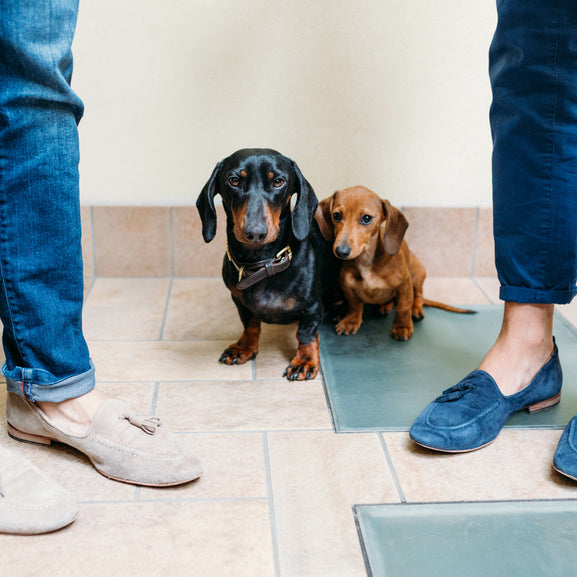
Recognize the signs
Though we’d love to speak the same language as our dachshunds, the next best thing is understanding what they’re trying to tell us. If your dachshund starts to actively sniff, circle the room, or run around excitedly out of the blue, they may need a bathroom break. Whining, sitting near the door, or giving you anxious, nervous stares are other common signs of a full bladder. To prevent routine accidents, it’s important for your pup to know that you’ll take them outside when they tell you they need to pee or poop, so you’ll want to react quickly.
If you’re having a hard time distinguishing between whines and are looking for a clearer sign that your pup needs to go outside, some people prefer to train their dachshund to ring a bell every time they need to go out. To do this, hang a bell by the door (at dachshund level, of course) and use treats to get them comfortable with it. Each time you go outside, encourage your pup to ring the bell, and they’ll quickly learn that it’s a great way to get your attention when they need a bathroom break.
Establish a routine
Dachshunds are little dogs, and that means they have little bladders, too. In fact, as pups, their bladders aren’t fully developed until they’re about 4 to 6 months old, so they’ll need even more frequent bathroom breaks when they first come home. Get in the habit of taking them out as soon as you wake up, shortly after they eat a meal, after playtime, before you go to bed, and every hour or so in between. Each time you take your dachshund outside, return to the same spot. This way, they’ll associate it with going to the bathroom — especially once they’ve gone enough times to associate the smells, too. You can also repeat the same verbal command each time so that they know it’s time to do their business — no need to differentiate between a command for peeing and pooping.
Potty time isn’t playtime
When you bring your doxie to their spot, it’s not the time to practice other tricks or start playing fetch. If they don’t go to the bathroom right away, wait patiently for five to ten minutes. No luck? Bring them back inside and try again in 20 minutes. What’s important is that your pup learns that going outside means that it’s time to relieve themselves — not to start chasing leaves.
Praise, don’t punish
Each time your pup pees or poops outside, shower them in praise. They’ve earned all the treats, belly rubs, and playtime! Your dachshund wants to please you, so seeing how proud you are when they do their business outside will encourage them to keep up that behavior. That said, when accidents happen, it’s important not to yell at your pup. The shame may actually encourage them to find hidden spots around the house to pee and poop. Instead, clean up the accident with a pet cleaner so that there are no lingering smells in the house that would encourage them to keep going to the bathroom inside, and focus on taking them outside regularly to prevent repeat accidents. If you do catch your pup starting to pee or poop indoors, firmly say no (firm, but not yelling!), scoop them up, and bring them outside to finish going to the bathroom. Reward them if they finish their business outside so that they know that they ultimately did the right thing!
Crates and playpens are your friend
Instead of letting your dachshund roam freely around the house, keeping them in a smaller space that they feel comfortable in while you’re potty training can help prevent unwanted accidents. If they feel at home in their crate or another enclosed area, they won’t want to go to the bathroom there. Just remember that they still will need to be taken out regularly, so you won’t want to leave them alone there for too long!
Consistency is key in many things, and housebreaking your pup is no different. Even if a few accidents arise, stick with regular training and rewards for successful bathroom breaks to continuously teach your dachshund that they’re meant to pee and poop outside. Puppy pads may sound like a helpful backup plan, but they reinforce that going inside is okay, so if you can avoid using them, you’ll likely be better off in the long run. Have patience with your dachshund as they learn, and before you know it, they’ll be pros at going outdoors!
